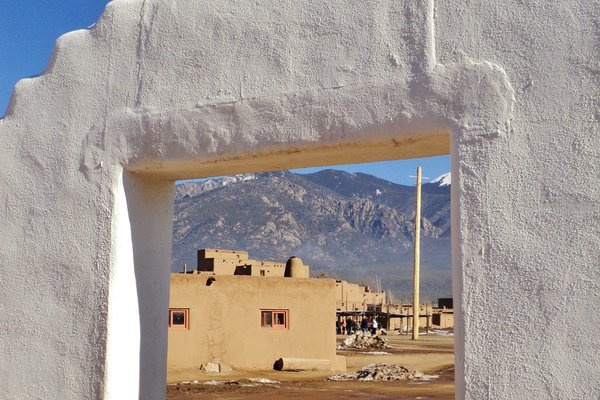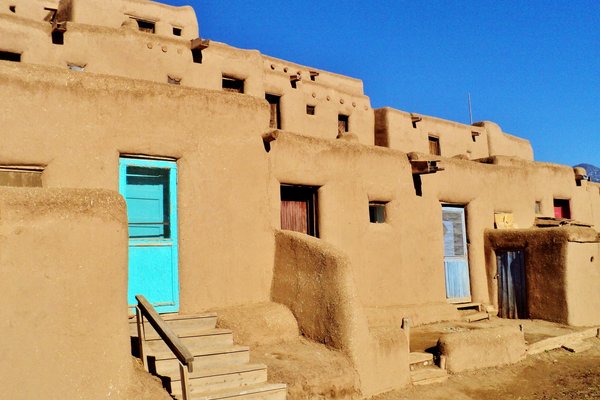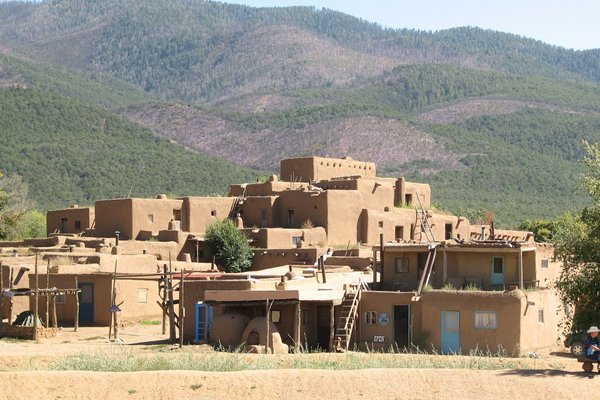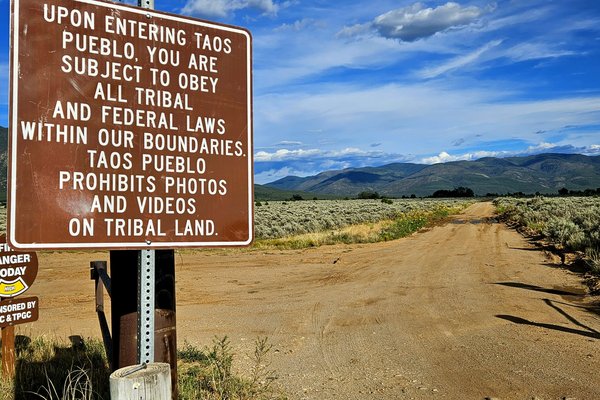United States of America
Taos Pueblo
Taos Pueblo is a traditional settlement from the pre-Hispanic period, that has been in continuous use until now.
The walled village consists of two five-storey adobe structures, kivas (underground ceremonial chambers), ruins of previous structures and a present-day Catholic church. It gives testimony to the culture of Pueblo Indians, that developed around 1400 after the disappearance of the Anasazi tribes in the region.
Community Perspective: an entrance fee is levied and many places in town are restricted areas, but most visitors find it an interesting experience. Joining a local tour and the bakery come recommended. Be aware that the pueblo can ‘close’ on short notice due to a funeral for example.
Site Info
Official Information
- Full Name
- Taos Pueblo (ID: 492)
- Country
- United States of America
- Status
-
Inscribed 1992
Site history
History of Taos Pueblo
- 2012: Name change
- From "Pueblo de Taos" to "Taos Pueblo"
- 1992: Inscribed
- Inscribed
- 1988: Deferred
- Until a comparative evaluation of Pueblo culture sites had been carried out
- Type
- Cultural
- Criteria
- iv
Links
- UNESCO
- whc.unesco.org
- Official
-
- taospueblo.com — Over 1000 years of tradition
- Related
-
- greatbuildings.com — Taos Pueblo on Greatbuildings.com
All Links
UNESCO.org
- whc.unesco.org — whc.unesco.org/
Official Website
- taospueblo.com — Over 1000 years of tradition
Related Resources
- greatbuildings.com — Taos Pueblo on Greatbuildings.com
Community Information
- Community Category
- Urban landscape: Urban continuity
Travel Information
Seasonal WHS
Recent Connections
-
Locations for playing sport
"The property includes ... a track for … -
Pueblo culture
"exemplifies the living culture of a gr… -
Georgia O'Keeffe
Georgia O'Keeffe painted Taos Pueblo on…
Connections of Taos Pueblo
- Individual People
-
-
Georgia O'Keeffe
Georgia O'Keeffe painted Taos Pueblo on a visit to New Mexico in 1929
-
- Trivia
-
-
Minority communities
Native Americans (tribe of Pueblo people) -
Customary ownership
Individual components of the Pueblo structures may be owned by or assigned to families or individuals but in its entirety, is owned by the community as a whole. ... As such, management is under the Pueblo’s governing body that includes the Tribal Council.See www.nps.gov
-
Role of Women
An exceptional example of a matriarchal society where traditionally homes and farm lands have been owned by women only.See www.blm.gov
-
- History
-
-
Insurrections
"New Mexico formally became a territory of the United States in 1847 with the signing of the Treaty of Guadalupe Hidalgo, but a revolt broke out in Taos Pueblo. Mexican Pablo Monoya and Tomasito, a leader at Taos Pueblo, led a force of Mexicans and Indians who did not want to become a part of the United States. They managed to kill Governor Charles Bent and others and marched on Santa Fe, but were finally subdued after taking refuge in the ill-fated San Geronimo Mission Church. The American troops bombarded the church, killing or capturing the insurrectionists and destroying the physical structure." - Wiki -
Pueblo culture
"exemplifies the living culture of a group of present-day Pueblo Indian people" (official description)
-
- Architecture
- World Heritage Process
-
-
Need for a Comparative Study
Until a comparative evaluation of Pueblo culture sites had been carried out - seems not to have taken place -
WHC locations
Santa Fe (1992) -
Inscribed on a single criterion only
iv. to be an outstanding example of a type of building, architectural or technological ensemble or landscape which illustrates (a) significant stage(s) in human history
-
- Religion and Belief
-
-
Living indigenous religions
Criterion (iv): Pueblo de Taos is a remarkable example of a traditional type of architectural ensemble from the prehispanic period of the Americas unique to this region and one which, because of the living culture of its community, has successfully retained most of its traditional forms up to the present day. - AB Evaluation. Traditional ceremonies and rituals are performed at the pueblo's four kivas. Furthermore, events such as the Turtle Dance, Deer and Buffalo Dance incorporate beliefs of the Taos Pueblo tribe. "The Pueblo religion is very complex; however, there is no conflict with the Catholic church, as evidenced by the prominent presence of both church and kiva in the village." - Official Taos Pueblo website -
Christian missions
"The missionaries' convent and church lie in ruins. A new church was built at a different location of the west side of the north plaza in the 19th century." - AB Evaluation. "Around 1620, the first Catholic Church in the pueblo, San Geronimo de Taos, was constructed. Reports from the period indicate that the native people of Taos resisted the building of the church and the imposition of the Catholic religion." - Wiki
-
- Human Activity
-
-
Locations for playing sport
"The property includes ... a track for traditional foot-races" (OUV) -
Art Colonies
The artists liven in the nearby town of Taos, but definitely get their inspiration from the Pueblo -
Festivals
Jan. 1, Turtle Dance - Jan. 6, Deer or Buffalo Dance - May 3, Santa Cruz Feast Day - June 13, San Antonio Feast Day - June 24, San Juan Feast Day July 12,13,14, - 28th Annual Taos Pueblo Pow-Wow - July 25, Santiago Feast Day - July 26, Santa Ana Feast Day - Sept. 29, San Geronimo Eve Vespers - Sept. 30, San Geronimo Day, Traditional Pole Climbing - Dec. 24, Procession of the Virgin Mary - Dec. 25, Deer or Matachines Dance (Official Taos Website - Events)
-
- Constructions
-
-
Cemeteries
The ruined San Geronimo Church (1619) and surrounding cemetery are located within the walls of Taos Pueblo. The US government destroyed the church in 1857 as retaliation for perceived crimes by native peoples. During the destruction of the church many people died within its walls. Hence the creation of the cemetery surrounding the church. - information from Wiki & Taos Pueblo brochure
-
- WHS on Other Lists
-
-
World Monuments Watch (past)
Concern about long term stewardship in the face of nearby developments and visitor numbers (2010)
-
- Timeline
-
-
Built in the 14th century
Taos is thought to have appeared before 1400. (AB ev)
-
- Visiting conditions
-
-
Seasonal WHS
Late winter to early Spring the Pueblo closes for about ten weeks. - Official Taos Pueblo website. This closure is due in part to both seasonal and resident accommodations.
-
- WHS Names
-
-
Name changes
From Pueblo de Taos (2012)
-
News
No news.
Recent Visitors
Visitors of Taos Pueblo
- Alejandro Lau
- Alexander Lehmann
- Alex Baranda
- Alex Goh
- AmyAbroad
- Anna Wludarska
- Antonio J.
- Atila Ege
- AYB
- beckyjo27
- Bill Maurmann
- Bin
- Brendan Carroll
- Brett Baumann
- brornt
- Celina Nanbara
- ChrisN
- Cluckily
- Cobaltrage
- Colossus
- Corinne Vail
- Cyberczar
- CynthiaSam
- Dagmara
- Daniel R-F
- Dan Pettigrew
- dave wood
- David Aaronson
- debatecoach
- Dolemite92
- Don Irwin
- Dorejd
- DouglasR
- DutchHorn
- Els Slots
- Erik G
- Errol Neo
- Eva Kisgyorgy
- Fan Yibo
- Filip Murlak
- Folkokovic
- Frederik Dawson
- Gary Arndt
- George Gdanski
- GeorgeIng61
- Iain Jackson
- Ian Cade
- IreneKD
- Jacob Choi
- Jacob Otten
- Jakob F.
- janameerman
- Janina Lehmann
- Jason Boulette
- Javier Coro
- Jay T
- jballard650
- Jeanne OGrady
- JJ10
- Joel on the Road
- KarenBMoore
- kayakka
- Kedp2023
- KeithBailey
- Kelly Rogers
- Kim, Soo-youn
- Kjlauer
- KngAlaric
- Kurt Lauer
- Kyle Magnuson
- Lara Adler
- leroykstlj
- Lillybett
- lindaann
- Ludvan
- Marty
- maryhattie
- Matthewrw
- Matthewsharris
- Max
- Michael Ayers
- MichaelH
- Michael Novins
- Mihai Dascalu
- MMM
- montgomw
- Mstrebl1990
- Naim Y
- Nicolas
- Nicole Lampos
- Nihal Ege
- Nuria8
- opperpco3
- Pchxiao
- Peter Lööv
- Pieter Dijkshoorn
- Pink Bunny
- Qin Xie
- Ralf Regele
- Randi Thomsen
- rivr
- RJPTravel
- Roel Sterken
- Roger Ourset
- Roman Bruehwiler
- Samy G
- sbshipway
- Shandos Cleaver
- Solivagant
- Stan
- StaziG
- Stefan Loov
- Sutul
- Svein Elias
- takanenohana
- Tamara Ratz
- Ted Coombs
- TheTravelingRanger
- Thomas Buechler
- Thomas van der Walt
- Tim Allen
- Timothy C Easton
- Tommy W
- tony0001
- Traveling Girl
- triath
- Truls Brekke
- Tsunami
- Vanessa Buechler
- Vincent Cheung
- vino4vino
- Walter
- Waters88
- WILLIAM RICH
- Xiquinho Silva
- ZCTLife
- Zoe
- Zoë Sheng
Community Reviews
Show full reviews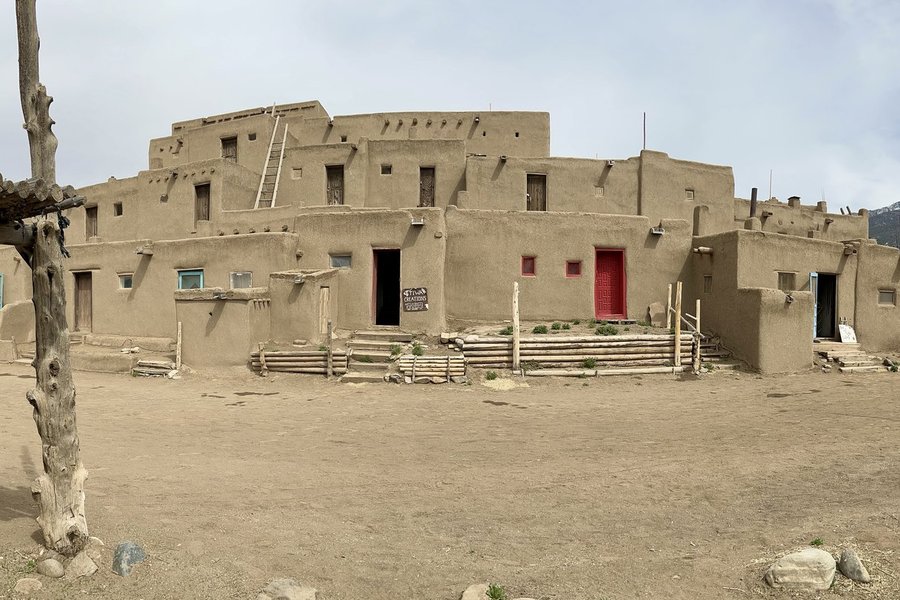
First, let’s get over paying for parking. I have been to hundreds of parks in the US, and even with a parks pass I have sometimes been forced to pay for parking. And those are national park units that receive annual funding from the federal government. Taos Pueblo receives neither rangers nor annual funding to provide parking or guided tours for visiting tourists. It is a privilege to visit. Pay to park, and thank the parking attendant.
Second, let’s step back and recognize what an extraordinarily special opportunity your visit represents. Over 500 years before Coronado visited or St Augustine Florida was founded, thIs pueblo was here. 1000 years ago, the Puebloan people were building multifamily dwellings, participating in religious ceremonies and trading with other communities. So, pay attention to the dwellings, the native religious elements and buy something local. There are precious few places on earth with such long, intact and continuing cultural traditions to experience first hand, speaking with the people who have lived here for so long, who continue to thrive, despite others‘ lack of understanding or support.
Third, let’s try to step outside our modern US-Eurocentric cultural boundaries and overcome some stereotypical misconceptions. Taos Pueblo is not important due to Georgia O’Keefe or DH Lawrence, who came here in the 20th century. This community is far older than Jamestowne or Plimoth. The church is new, dating back only 175 years. The ruins of the old church next door date back to the 17th century, so it …
Keep reading 1 comment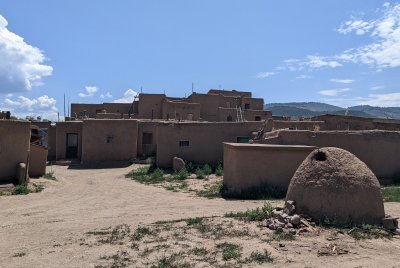
I loved the Taos Pueblo! We went on a day trip from Santa Fe in July 2024. It was a very hot day but we still enjoyed walking around. It was bigger than I thought - I had seen pictures of the main building but didn't realize it was a whole village. Beautiful architecture. It's a picturesque spot with lovely mountains in the background. You can't go everywhere, but can still see a lot. Our tour guide was a young woman from the Taos Pueblo who was in college but came back in the summers, and had some interesting perspectives on both historic and modern life in the pueblo. There weren't too many people there, but we also enjoyed talking with a few of the shopkeepers. A really unique experience! We saw interesting abandoned pueblo ruins in New Mexico at Bandolier National Monument (which I highly recommend) and also Pecos National Historic Site, but at Taos it's amazing because the pueblo has not been abandoned, it's been kept up for 1000 years using the same techniques. A must see if you're interesting in Native American history and life.
Keep reading 0 comments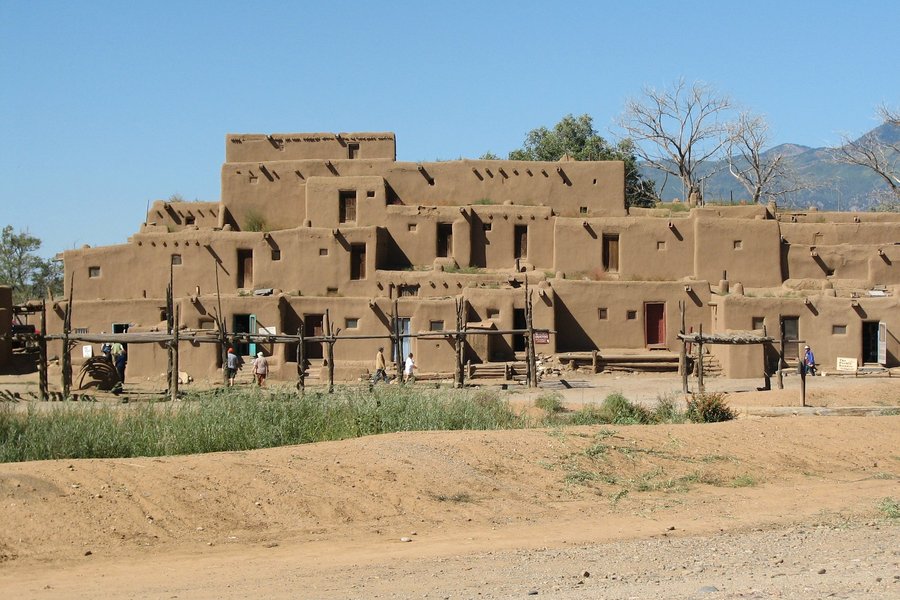
We just did a trip visiting all three Pueblo WHS in the Four-Corners area: Mesa Verde, Chaco Culture and lastly Taos Pueblo as a theme. The first two are managed by NPS while Taos Pueblo is managed by locals. The first impression was that it is a money-making enterprise, they charged admissions of $22 pp. The guided tour started with an introduction of the Pueblo cultural history, but it was everything we have already heard at the other parks and less. We had expected a perspective from a Native but the guide seemed to just read the information from the NPS brochure. She did not forget to ask for a gratuity. We asked about the painting of a girl in the church, but she did not know the identity of the subject.
The site viewed from the outside was not that different from many other adobe style buildings. The residential areas are not open to the public, which is understandable, but the only houses that were open are the ones selling high-priced souvenirs and baked goods. We had expected to see an exhibit sample residence.
This WHS was probably designated due to "continued residential use", but as a site, it was not worth visiting given all that's around in the area.
Keep reading 0 comments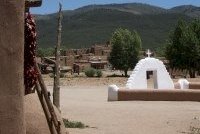
June 2012 - After having spent a highschoolyear in Colorado in 2004/05 I finally wanted to come back to visit my hosts, and to show my now wife, how intersting and adventurous the USA is. We landed in Denver, spent 2 nights with my hosts and began a 3,5 week roadtrip. Our first night was in Sand Dunes NP, next morning we continued to Taos. Taos is a small Santa Fe we were told, with lots of art galleries and manufactures.
The Pueblo is a bit outside and different than the NPS Run sites it is a bit more commercialized. The Native Americans who live here, try to make a living in chraging for parking, Photo permits and smelling corn and artwork. You can go into some Pueblos, the church however was Tabu, at least photography when I remember correctly.
We spent about an hour and continued our journey West to a Statepark campground.
Keep reading 0 comments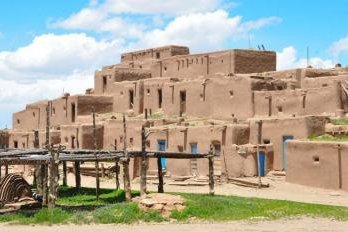
When I reached Taos during the Memorial Day weekend, I was extremely shocked to see congested traffic in the town because of many tourists; I was really worried that my visit to Taos Pueblo will be ruined with chaos of sightseers. However, when I reached Taos Pueblo area, the road become dirt and the whole area were obscured by small sandstorm. When I managed to reach the car park outside the village, I was surprised that the car park was almost empty! After waited inside the car until the sandstorm gone, I got out and met by the guards who told me to buy ticket at the office opposite the village main entrance. After paid $16 I got a pamphlet which has small history of Taos Puebla and village map, no ticket or inspection at the entrance.
According to the pamphlet, Taos Puebla, the Place of the Red Willows, is the oldest continuously inhabited community in USA and the first living World Heritage Site. Judging from the old buildings I saw, I was quite understood why they claimed to be the oldest, but to be the first living WHS was really questionable since I did not understand what that means. The first thing I saw was the ruin of San Geronimo destroyed by US army in 1847 and cemetery showing that this place was not a peaceful village throughout the history. Then I saw the current San Geronimo Chapel, the church was fine, but I think it was too …
Keep reading 0 comments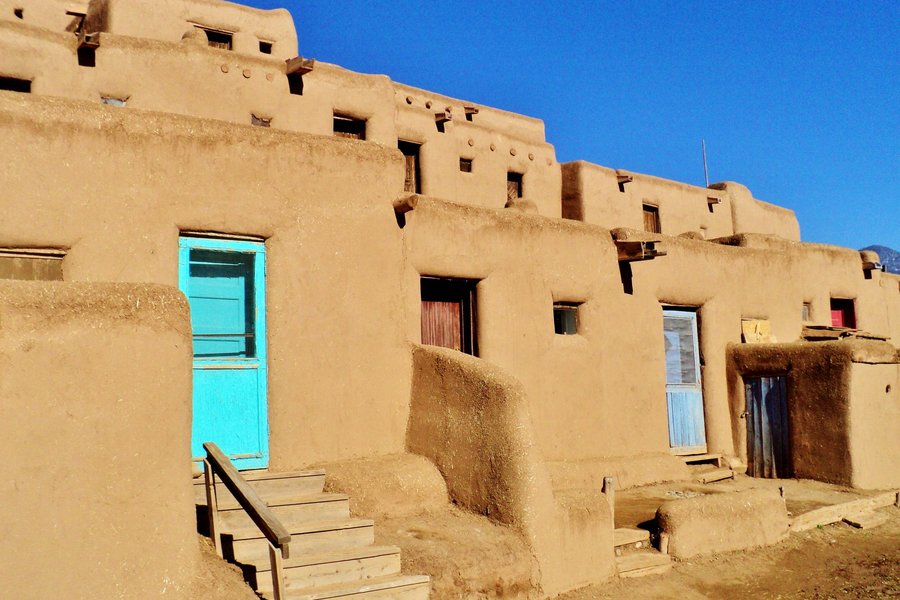
On the morning of November 30th, after a short drive from Santa Fe, my wife and I reached Taos Pueblo. I knew all the particulars about price, pictures, and the general rules. However, I was pleased to learn the photo policy has changed. There are no longer any restrictions or fees about general use of cameras within the Pueblo. A guided tour is optional, but is certainly worth it. You can explore the pueblo at your leisure before or after.
There has also been other positives for the Taos Pueblo community in recent years. The pueblo has seen a recent increase of inhabitants living full-time inside the pueblo. Restricted portions of the pueblo are primarily areas that lead to 4 traditional kivas that are only accessible to tribal members. There is also a elementary school in the rear of the North section of Taos Pueblo. This school does teach the local language of Northern Tiwa.
The Taos Pueblo used to be guarded by a more defensive wall, but today it is a very short enclosure. The North side of the Pueblo (Hlaauma) is divided by the Red Willows Creek from the South side (Hlaukkwima). Most of the pictures tend to be of Hlaauma, but using small bridges one can visit the older Hlaukkwima area of the pueblo. (Up to 1000 years old) My picture is of this area, one can see the general condition of this area is slightly more worn down by time.
The 19th century church near the …
Keep reading 0 comments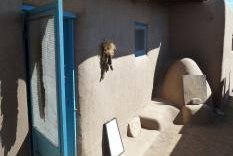
The main thing that stuck with me after my visit was how "authentic" the Pueblo was. With the exception of the odd bit of plastic guttering and a portable-toilet there were no discernible traces of modern materials or techniques. Walking on the dusty ground between a few of the crumbling buildings near the cemetery I could easily have thought myself back in a remote village in West Africa. This is actually pretty impressive; there must be lots of pressures to modernise both internal and external, but it is a real testament to the inhabitants that the site isn't just a museum, unlike other historic small settlements on the list.
We arrived shortly before a tour was about to start so decided to join in, and I'm glad we did. It was conducted by an informative local who was also studying at a nearby university. It helped to give a resident's perspective on history (and even the concept of history), religion, the functions of buildings, annual celebrations as well as life with-in the pueblo, though many residents also have homes elsewhere in the reservation. I was interested that there seemed to be a begrudging acceptance of being in the USA rather than whole hearted support for it.
We had a quick walk around after the tour, bought a few (surprisingly expensive) goods baked in the ovens and took some photos then headed on out.
The pueblo is just outside the city of Taos, which I must admit was a massive disappointment. …
Keep reading 0 comments
Taos Pueblo is a fascinating place. We drove 1 1/2 hours from Santa Fe to the pueblo, only to find that it was closed for a funeral. Visitors must be prepared for the pueblo to be closed at any time (for weddings, funeral, or other ceremonies). Funerals can take up to four days and luckily for us, we tried to visit on the fourth day. We went back the next day while there were heavy winds and sand was blowing in our faces. It didn't matter; I was determined to see the pueblo.
I highly recommend going on a tour provided by one of the pueblo residents, as you get a brief history of the pueblo. Also, if you want to go inside a home, the only way is to visit one of the many shops. There are many micaceous pots (the style of pottery done by the Taos people), drum, horno-baked bread, and other souvenirs for sale. Upon leaving the pueblo, it is worth it to visit the art center run by Marie Reyna and Tony Reyna Indian Shop.
Keep reading 0 comments
Christmas Eve and Christmas Day at Taos Pueblo are among the most transforming experiences of my long life. My husband and I, with my daughter, son-in-law, and three grandchildren, were overcome by the beauty of the church service, the wild glory of the bonfires, and the mystery of the dances. We have also attended the San Geronimo pole climb twice. Another treasured memory: sacred clowns on the roofs of the pueblo, the unparalleled courage of the young men at the pole climb, and, as always, the kind welcome of the Taos Puebloans.
Keep reading 0 comments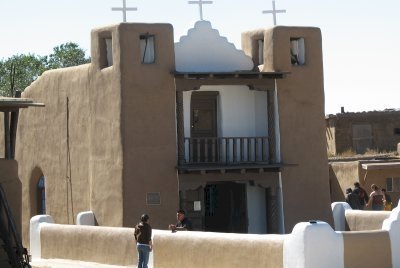
When you arrive at Taos Pueblo (just north of modern Taos), you are confronted with a gate and a big parking lot at the entrance of the town. As it is both a historical site and there are still about 150 people living here, it's kind of a working museum village. You have to pay an entrance fee for yourself and your camera to get in (10 + 5 dollars). Despite the worries stated in Paul Tanner's review below (his visit dating from 1963), it has not become too commercialized however in my opinion. People keep their distance, and there are large parts of the town and the surrounding grounds that are only open to locals.
From the pictures I had seen, I imagined that the Pueblo would be on a hill, but it turns out to be a flat square with two large building structures on either side (the North House and the South House). These are all individual living quarters that share walls. The entrance used to be via a ladder from the roof.
The pretty San Geronimo church also is on the central square. Some locals were just adding a fresh layer of white and beige paint to its thick adobe walls. Catholicism has clearly been incorporated into contemporary Pueblo culture.
I roam around between the houses for a while. You can't go very far: many places are restricted areas. It reminds me of Mali: the simple adobe buildings, the harsh sunlight. Or I …
Keep reading 0 comments
Pueblo de Taos is just terrific. I really enjoyed
seeing and participating in authentic native American
culture that dates from approximately 600 years ago.
It is very rare to see a culture this old in the USA.
The architecture and the culture of the pueblo will
captivate you.
Keep reading 0 comments
In genealogy research for my children's paternal heritage, the Taos Pueblo was welcoming and happy to meet us. In our Class "A" motorhome, we stayed at a new-found elder family member's adobe outside of the area of the adobe apartments. We were there for a couple weeks learning their heritage and having a couple of BBQ's for meeting family. We enjoyed all this immensley. Their hospitality was impeccable.
LK
Keep reading 0 comments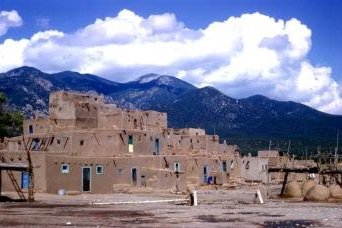
From houses to shopping malls to hotels – indeed, wherever you go in the SW USA you will see examples, from the good to the clichéd, of “Pueblo Revival Architecture”. Its current manifestation is even called “Southwest Architecture”. At Taos Pueblo you can see the “original” article still lived in by “Native Americans”.
How worthwhile you find the experience will depend on
a. How interested you are in adobe architecture. The basic structures date back possibly 1000 years and are regularly “resurfaced”. Although they are stated to be “multi story” and there are parts of the structures which reach 4 floors you are not actually allowed to climb up as these are private or ritual houses and many of the buildings are single story. The whole structure is a series of interlinked square structures – this is no Shibam or Djenne with mud towers and wonderful shapes
b. How much you “want to get a feel for” Native American culture and how you react to the circumstances under which such a visit takes place. One must have some sympathy for the inhabitants. What do you do if you live in a village of 150 people where hordes of tourists want to come and gawp at you and your houses? Well you charge them quite a lot of money to come in (at limited times), you make them pay to take photos (and try to stop them taking photos of you because otherwise it gets very wearing), you provide lots of …
Keep reading 0 comments
We visited on Christmas Eve 2006 and had a wonderful experience. The Pueblo generously did not charge its usual admission fees that day, although prohibited the use of cameras.
We arrived around 1530 and were provided an unofficial tour by a resident working for tips. He provided a good deal of historical insight, although discussions about the native faith of the Taos Pueblo people were declared off-limits. He did provide some insights into the flavors of their own practice of Catholicism that stem from the original religion. The tour was limited to the outdoor areas. He directed us to a number of the "shops" that were open selling Pueblo-produced breads, crafts, and souvenirs. The most impressive offered a wide range of contemporary art and pottery from Taos Pueblo and a number of other Pueblos. Most shops offered goods of a high level of craftsmanship rather than souvenirs.
The church was open to visitors for the evening service, although could in no way accomodate even a fraction of the people who had gathered by 1700. As a note, there were eventually more than one thousand people there in my estimation (perhaps 2000), so do arrive early in the day before the nearby parking is full.
After the evening service, there was a procession featuring the Virgin Mary, native dancers, riflemen, and many residents in Pueblo dress. To light this procession, there were literally one hundred bonfires of locally gathered "greasewood" (an intensely combustible but highly smoky wood). Most of these bonfires …
Keep reading 0 comments
